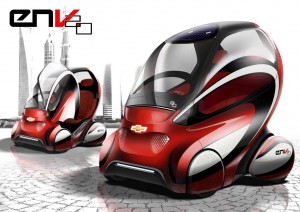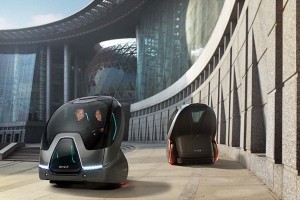It looks more like an electric rickshaw than a conventional automobile – which may be one reason why General Motors chose to unveil its second-generation “Electric Networked Vehicle” at Auto China 2012.
But the little 2-seater points to the future of transportation, rather than the past, according to Kevin Wales, the president of the GM China Group, who called EN-V 2.0 “a more practical design” than the quirky little runabout the maker originally introduce in Shanghai two years ago.
The first, pod-like EN-V might have looked like a concoction whipped up for a sci-fi adventure film but it was deadly serious and aimed at solving some of the most pressing problems facing automotive manufacturers, regulators and motorists alike: the need to eliminate automotive emissions, reduce energy consumption and minimize traffic snarls, especially in car-choked cities like Beijing or Shanghai.
The first-generation EN-V was not only small enough to need little roadway but was also designed for “platooning,” riding in bumper-to-bumper formations, even at highway speed. It would do that by digitally communicating with other vehicles around it. Being part of a smart infrastructure would permit far more vehicles to be packed onto a given stretch of roadway – all while reducing collisions.
Meanwhile, EN-V 2.0, like the first-generation EN-V, uses a compact lithium-ion battery drive system rather than conventional internal combustion technology. Relying on extremely lightweight materials would sharply improve the 2-seater’s range, contend GM engineers.
One of the most significant changes from gen-one to gen-two is the addition of a second pair of wheels. The original EN-V operated something like an enclosed version of the Segway personal transporter relying on a complex system of gyros and motors to maintain stability with only two side-by-side wheels.
The new 4-wheel approach is more efficient, said Wales, who presented renderings of the new version during a presentation at the Beijing Motor Show. What might matter more to passengers is that EN-V 2.0 also gets a working climate control system and some storage space.
“Our designers and engineers are exploring a range of options for turning the EN-V concept into a reality,” said Wales, though he cautioned it is likely to be some years before such technology becomes truly practical.
But, then again, some observers suggest it may not be as far into the future as once was believed.
There’s growing interest in so-called autonomous, or self-driving vehicles, and makers like Ford and Volkswagen have improved their prototype technologies substantially in recent years, as has Google, the Internet giant that also wants to become a leader in the technology.
That company’s active involvement is no surprise. “The EN-V 2.0 concept would use technologies such as the mobility Internet, electrification and telematics to help change the automotive landscape and ensure a sustainable future for our industry,” said Wales.
The concept of autonomous driving is actually proceeding at such a rapid pace that Nevada recently became the first state to enact specific rules covering driverless vehicles. That still will mean having a human onboard ready to take over quickly in the event of a technical malfunction – and no drinking and not-driving, Nevada lawmakers decided.
GM will have an actual operating vehicle of its second-generation N-V 2.0 concept ready in the months ahead and will build a small fleet of pilot vehicles in the near future for more expansive testing in China.


